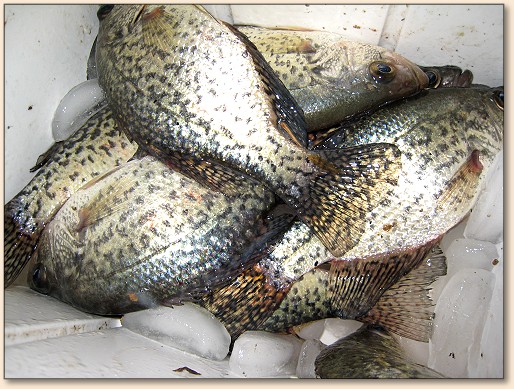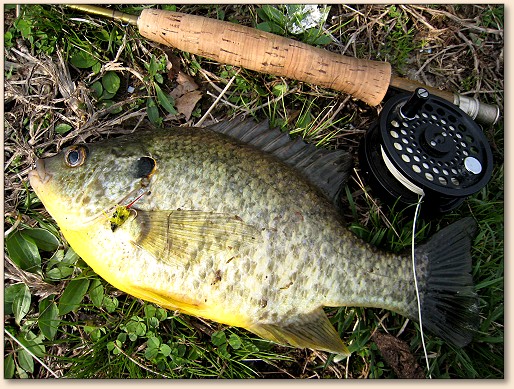|
After my first outing of this year, during which I
enjoyed good luck on bluegills and crappie, I reflected
on the fact that I had used a fly tied by a fellow fly
fisher. During that first trip the fly that brought
home the bacon was a Pheasant Tail Nymph. The more I
thought about it the more appealing the idea became to
experiment – to broaden my horizons – by forcing myself
to use some of the flies that generous people have given
me or mailed to me over the last three years. The
population of these "gift flies" has become fairly sizeable.
It's not easy for me to try other people's flies. My all-time
favorite fly is a "store bought" #10 flashback Hare's Ear Nymph.
"Old Reliable" has proven so lethal that I find it difficult
to understand how anything more can be gained by knotting
something different to my leader. Yet on my first trip out
this year it was my own logic that persuaded me to forgo
Old Reliable and use a PTN.
That I caught not just "fish" but early spring crappie on
Rick Zieger's PTN only pried the door farther ajar, in terms
of opening my mind to the possibility that the other flies
I've been given may also be very good indeed – possibly as
good as Old Reliable if used properly in the correct
circumstances. But how do I know when is an ideal time to
use these different flies? In which environments are they
most effective?
This is where I confess to being as reluctant a learner as
anyone. It isn't often I reach into my fly box and select
a pattern I've never used before and know nothing about.
I frequently consider doing it, I'm just reluctant. Truth
is I spend more time than you might suspect studying the
on-line information sharing interplay between fly fishers,
especially the "micro-stories" everyone posts in the FAOL
Bulletin Board.
So after racking up around thirty catch and release bluegills
and crappies on Rick's Pheasant Tail Nymph, I remembered a
Bulletin Board post made last year by Florida's Robert
McCorquodale. In that post, he mentioned that one of his
favorite ways to catch crappie is to slowly drift a McGinty
fly a few feet out from a grassy shoreline. Trying to
duplicate Robert's tactic seemed like a reasonable idea,
given that the crappies I'd caught earlier using the PTN
were hooked reasonably close to shore. During the interval
between that trip and my next one they could have moved
closer yet to shore. The stage might be set, then, for
some McCorquodale McGinty McMayhem.
A rainy day Tuesday was my first chance to get out to the lake.
But I was hot to go: only lightning was going to keep me away;
I would fish standing in the cold March rain if need be. As
it turned out, the storm system I'd been monitoring all day
on National Weather Service radar had developed an open "elbow"
in its right hook-shaped structure. This pocket of less intense
weather looked as if it would move over my lake by the time I
got there from work; an eye in the storm, as it were. So I
went and sure enough, there was no rain, no lightning, very
little wind, and no other people fishing.
I proceeded directly to the spot where a few days earlier I'd
caught the first PTN-tricked fish. After lining my rod, I
decided to extend my somewhat abused leader by surgeon-knotting
a 24-inch length of 4X tippet to its end. Having a long,
thinner diameter tippet seemed warranted because a McGinty
fly's body is fluffy and bulky, giving it a fair amount of
water resistance as it sinks. Absent this tippet extension
the McGinty might have difficulty overcoming the surface
tension resistance of my old leader's thicker diameter. I
needed the fly to settle to crappie depth (whatever that
was today) but I was gambling the fish were shallow and would
be attracted to something slow-moving.
In no time I had my first fish, a black crappie male nine
inches long. I'd thrown McGinty about 25 feet out from
the bank, given it a ten second countdown then brought it
back with a figure-8 line pickup. The crappie had seized
the fly at a point some 20 feet off shore, grabbed it maybe
two feet below the surface in water around 5 feet deep.
Tonight I was fishing for the table. Thinking the party
had started I dropped this first crappie into my small ice
chest and threw out again. And again…and again. But to no
avail; that first crappie was the only one this spot wanted
to give up.
Obeying the panfisher's maxim ("If you don't get a hit in 10
minutes, move"), I moved. Down the lake shore I tippy-toed,
stopping to fan cast any spot that offered a narrow lead
through the standing shoreline weeds combined with open
terrain behind, necessary for false casting.
What happened was I discovered that big bluegills are quite
fond of the McGinty pattern. Either that or the dirty rats
had read my mind (that I was keeping only crappie tonight)
and were taking turns jumping on the McGinty to enjoy an
invigorating aerobic workout struggling against my 00-wt.
Sage. Big 'gills – keepers any other time – were wearing
out my right arm and wrist.
As for the crappies I'd come here for, their strikes were
few and far between. I left the lake a little after 8 p.m.
with eight keepers. It was dark when I caught the last fish,
making me wonder if I could have continued. Probably so, but
once it got dark I began having the most devilish leader snarls,
some it was all I could do to unravel. Plus I had to drive
home and clean these fish, then get some sleep before tomorrow's
4:20 a.m. workday wakeup. So I quit with eight fish on ice.

Looking at my watch and doing the math, I'd caught crappies
this evening at a rate of one every 20 minutes. Not red hot
action to be sure but, hey, better slow than no show. The
day will never come when you hear me gripe about catching "only"
eight crappies: that's a high quality fishing trip in my book,
and plenty for a good meal.
Each crappie I caught was a male fish. This leads me to
speculate that the reason why so many big bluegills were
in the vicinity (and perhaps grabbed the McGinty before a
crappie could reach it) is that the 'gills have ganged up
anticipating the crappie spawn. Soon the female crappies
will ease in from deeper water and commence egg-laying.
Once that happens it's Feast Time for Bluegills…and they
know it.
Before wrapping up this account of a trip where I deliberately
used only a McGinty, I feel it's necessary to say that I doubt
the ideal circumstances were in place for this fly to demonstrate
its effectiveness on shallow water crappie. If my Bulletin
Board memory serves, Robert McCorquodale's "drift past the grass"
presentation is a tactic he employs during off-spawn months, such
as early morning or late afternoon low-light periods during summer
when crappie sneak in close to prowl weedy and grassy borders in
hopes of picking off careless insects.
Wouldn't it be funny if the McGinty is a fly that ONLY works
when it's presented in close proximity to shoreline weeds or
grass? I say this because of what happened three days after
this eight crappie trip.
I couldn't resist going back to the table for another helping,
right? Well, on my third cast one of my darling Old Reliables
got grabbed by a 3-lb. largemouth bass that fled into a
submerged limb, wrapped me then jumped and broke me off.
Heartbroken at the loss of Old Reliable and resolved to try
a pattern that largemouth bass might find unappealing, I tied
on the exact same McGinty fly I'd caught those eight crappies
with. A few minutes later I was swimming it past the edge of
a medium-size patch of floating algae when the creature pictured
below spied it and took violent interest:

This is the second-biggest red ear sunfish I've ever caught.
The McGinty fell out of the fish's mouth just before the photo
was taken, which is why the fly is lying near the fish's gill
cover; I laid it there so you can see it. Big Boy is still
swimming in the lake because I released him immediately after
the photo. I hope this monster doesn't hold a grudge, but
judging by how hard he fought and that look in his eye he's
out there right now waiting to pop my leader next time our
paths cross. ~ Joe
About Joe:
 From Douglas County, Kansas, Joe is a former municipal and
federal police officer. In addition to fishing, he hunts
upland birds and waterfowl, and for the last 15 years
has pursued the sport of solo canoeing. On the nearby
Kansas River he has now logged nearly 5,000 river miles
while doing some 400 wilderness style canoe camping
trips. A musician/singer/songwriter as well, Joe's
'day job' is with the U.S. General Services Adminstration.
From Douglas County, Kansas, Joe is a former municipal and
federal police officer. In addition to fishing, he hunts
upland birds and waterfowl, and for the last 15 years
has pursued the sport of solo canoeing. On the nearby
Kansas River he has now logged nearly 5,000 river miles
while doing some 400 wilderness style canoe camping
trips. A musician/singer/songwriter as well, Joe's
'day job' is with the U.S. General Services Adminstration.
Joe at one time was a freelance photojournalist who wrote the
Sunday Outdoors column for his city newspaper. Outdoor
sports, writing and music have never earned him any money,
but remain priceless activities essential to surviving the
'day job.'
|



 From Douglas County, Kansas, Joe is a former municipal and
federal police officer. In addition to fishing, he hunts
upland birds and waterfowl, and for the last 15 years
has pursued the sport of solo canoeing. On the nearby
Kansas River he has now logged nearly 5,000 river miles
while doing some 400 wilderness style canoe camping
trips. A musician/singer/songwriter as well, Joe's
'day job' is with the U.S. General Services Adminstration.
From Douglas County, Kansas, Joe is a former municipal and
federal police officer. In addition to fishing, he hunts
upland birds and waterfowl, and for the last 15 years
has pursued the sport of solo canoeing. On the nearby
Kansas River he has now logged nearly 5,000 river miles
while doing some 400 wilderness style canoe camping
trips. A musician/singer/songwriter as well, Joe's
'day job' is with the U.S. General Services Adminstration.